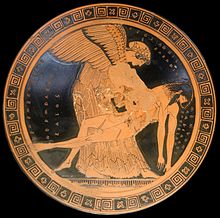Favorite inscription

Favorite inscriptions are mainly found on painted Greek vases and praise a person, usually a young man, as "beautiful" (kalós).
Another expression for these inscriptions is the Kalos inscription ( ΚΑΛΟΣ , ancient Greek for beautiful , sometimes the feminine form kalé ). These inscriptions, which were applied before the vessels burned, are intended to praise the beauty of certain people. In addition to the permanent inscriptions, graffiti could also have been scratched into the vases afterwards.
Origins

Favorite inscriptions resulted from the interest in youthful beauty, which has been known since early Greek poetry. The inscriptions also reflect current pederastic social conventions; the pedagogical eros , which is the subject of Plato's symposium , for example , is certainly also in the background of the Kalós inscriptions.
In addition, the general ideal of the aristocratic youth is praised. The use of such inscriptions on vases and the depiction of scenes playing in palaces overlap in time, so that the assumption is justified that the praise relates primarily to the physical beauty and athletic prowess of boys and young men. The favorite inscriptions undoubtedly reflect the “stars” of this world who have just been particularly praised and celebrated.
Some of the ephebes known from the inscriptions, such as Leagros, Miltiades , Diotimos or Glaucon, can possibly be equated with later Athenian strategists , but this can rarely be clearly clarified. In research it is discussed whether the Kalós names that are recurring with certain artists or workshops are not due to commissioned work.
Traditional testimonies, painters and motifs

Today around 300 favorite inscriptions are known on Attic vases, two thirds of them on vessels in the red-figure style. The first inscriptions were created around 550/540 BC. The painter Exekias or another artist from group E for Stesias and Onetorides. Later a Memnos is preferred Ephebe of Oltos , while Euphronios and his circle prefer Leagros . Epiktetus praises Hipparchus, Epikylos the Scythians .
During the pioneering days of red-figure painting, individual vase painters also appeared as kalós among their colleagues. In the 5th century BC BC Onesimos favored Athenodotos and Panaitos, Duris the Chairestratos and Hippodamas, whom Makron also praises. Around 470 BC The Pistoxenus painter mentions the son of Leagros, Glaukon, and ten years later the Achilles painter Diphilos, son of Melanopus. Shortly afterwards, several painters even praised Euaion , the son of Aeschylus. Towards the end of the 5th century BC, the custom of favorite inscriptions ended. One of the last representatives was the Eretria painter , who repeatedly praised the younger Kallias .
Research today has given names to several anonymous painters based on the Kalós inscriptions they used. These include the Antimenes Painter , the Lysippides Painter , the Antiphon Painter , the Euaion Painter, and the Cleophon Painter . The longer creative periods of some painters are divided into periods named after their ephebes, for example Duris and the Achilles painter.
literature
- Wilhelm Klein : The Greek vases with favorite inscriptions. Vienna 1890. (2nd, improved and enlarged edition. Leipzig 1898)
- François Lissarrague: Publicity and performance. Kalos inscriptions in Attic vase-painting. In: Performance culture and Athenian democracy. Cambridge 1999, pp. 359-373.
- Niall W. Slater: The vase as ventriloquist. Kalos inscriptions and the culture of fame. In: Signs of orality. The oral tradition and its influence in the Greek and Roman world. Leiden 1999, pp. 143-161.
- Stefan Brenne: Indices for Kalos names. In: Tyche . 15, 2000, pp. 31-53.